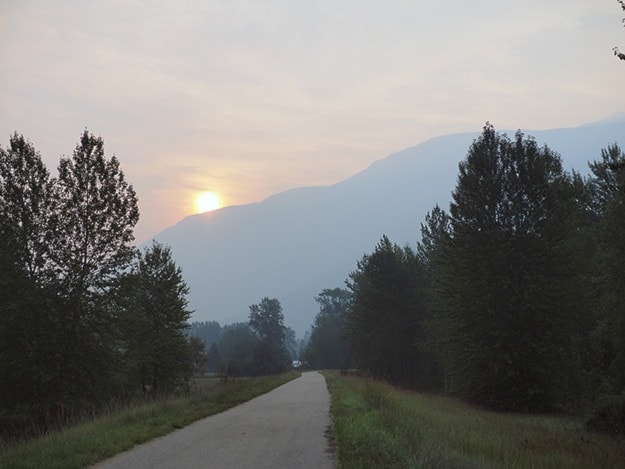Last week, as wind blew smoke from raging fires in the western United States to Revelstoke, a strange thing happened. While smoky skies and air quality advisories were issued for much of the Kootenays, Okanagan and Shuswap, there were no such warnings for this area.
Why was that? Was it not so bad here, despite the fact visibility was less than a few kilometres at points?
To find out, I called the B.C. Ministry of the Environment, where, after three calls, I finally heard back from Ralph Adams, an air quality meteorologist based out of Kamloops.
The answer was both simple and discouraging.
"When we issued the advisory earlier this week for the whole Kootenay and Boundary region we assumed that included Revelstoke & Golden," he told me. "We found out later according to Environment Canada you're part of a different region."
That answered one question, but our conversation revealed some other interesting things.
The first is that there is no air quality monitoring station in Revelstoke. There was one until last year, when it was removed from the roof of the fire hall — a decision made by city staff.
"It was installed with the intention to help monitor the air when we had the Downie Street beehive burner," said Dawn Levesque, the corporate officer for the City of Revelstoke.
The agreement with the Ministry of the Environment expired in 2012 and because the machine made it difficult to shovel the roof, it was removed last year. "There were always liability issues with the equipment," Levesque said.
There were discussions to move the equipment to the roof of the new Visitor Information Centre, but those fell apart.
"They seemed keen and we sent stuff back and forth, and then they just dropped off the map," said Alan Mason, the city's director of economic development. "I don't know what happened."
Without an air quality monitoring station, the Ministry of Environment looks at the highway cameras to see how smoky it is in the region.
Air quality stations can be set up to detect a number of toxins in the air. The ones that are used to produce the Air Quality Health Index measure the levels of nitrogen dioxide, ozone and particulate matters in the air. The first two are gases that can be harmful above a certain level, while the latter are microscopic particles floating in the air.
Particulate matter, or PM as it's abbreviated, is measured at PM10 and PM2.5 – the number refers to the size of dust molecules in micrometres. It's these invisible particles that are considered a health hazard. "Dust that you can see, you cannot breathe in. It gets stuck in your nose," said Adams.
The PM2.5 molecules are regarded as the most dangerous because they're so small they can become embedded in the lungs. In B.C., a PM2.5 level of more than 25 micrograms per cubic metre over a 24 hour period will lead to an air quality advisory. Inhalation of high levels can lead to asthma, cardiovascular and respiratory diseases, and lung cancer.
This leads me to the concerns over the gravel pit. Inhalation of fine silica that concerns gravel pit opponents can lead to silicosis and lung cancer. There is little evidence that inhaling crystalline silica is a concern for the general public, but there's also been very few studies on its impact. The best argument I've heard that it isn't a concern is that if it was, silicosis would be much more common.
Right now we don't even know what our quality is like, which is a worry. Without a monitor, air quality officials have to check the highway cameras to see smoke levels in the area.
We don't live in a smog-filled metropolis like Beijing, but I'm of the opinion that having the data is preferable than not having it, especially with smoke from forest fires becoming more prevalent. The cost to run the equipment was about $10,000 per year and it was paid for by the Ministry of the Environment, aside from some incidental costs incurred by the city. It seems like a cheap price to pay for air quality information.
For Adams, he just hopes people are smart enough to realize that if they're having trouble breathing, they'll go inside where the air is usually cleaner. That's the messaging they want to get out, whether an advisory is issued or not.
The smoky skies advisories issued by the Ministry are a new thing. They were set up to get a health message out to vulnerable populations as a preventative measure, said Adams.
"When it comes down to it, the main health messaging is directed to those members of the population who have pre-existing conditions," he said. "In that case, the messaging is to try and reduce your exposure."
Those conditions include asthma and other respiratory ailments. People with conditions are advised to take it easy and stay inside. "It takes some time for the air inside a building to reach the same concentration as the air outside," said Adams. Air-conditioned buildings are also healthier because the systems often contain air filters. In Adams' perfect world, the advisories would be unnecessary because people would know what to do once they noticed it was smoky.
"If you're doing something and you start to have trouble breathing — well maybe stop," he said. "The fact we have to tell people that is kind of shocking."
